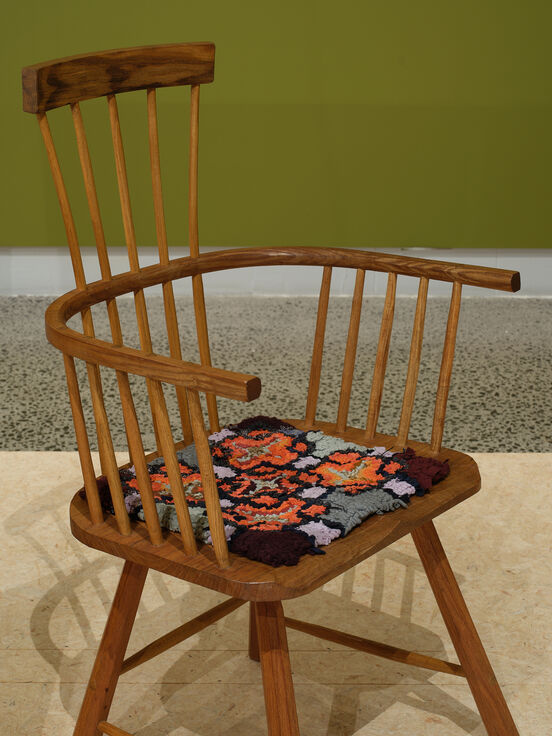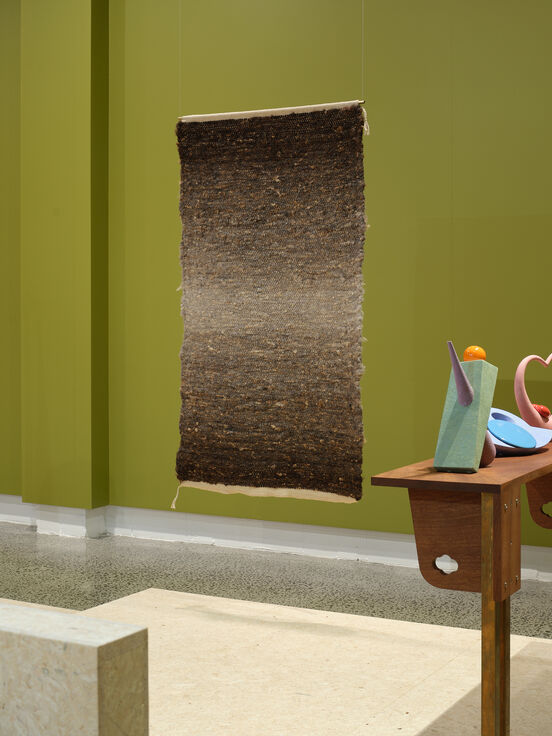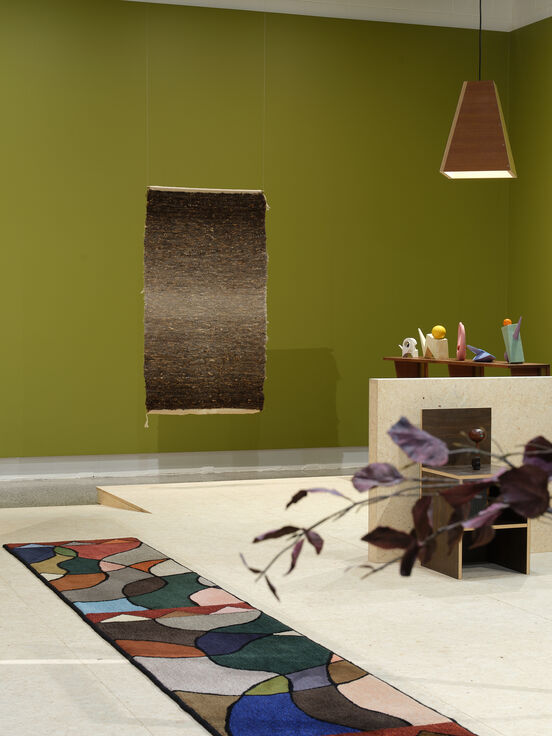How to make a home with… Annie Mackenzie
Annie Mackenzie is one of 14 artists, makers and designers exhibiting in How to make a home, a show exploring the small universe of home and the material politics of the objects and adornment we live with over time. We asked Annie four quick questions about their work in the exhibition and what makes a home, read her responses below.
—
Objectspace: Can you briefly describe the material and making of your works in How to make a home?
Annie Mackenzie: Stock is a fleece rug. She is the full fleece from a Romney ewe. All the different shades came from that one ewe. Her legs and belly are the darkest shades moving up to her sunbleached grey back. She is an ode to the beauty of the material that is wool, to a season and to a life.
Persimmons is a rag rug I made as a teaching aid to encourage coasters to do some creative healing after the pandemic. It started with a drawing of some fruit in the bowl. The 'rags' are a combination of wool, cotton and silk. I like finding things in the dog bin at op-shops or the 50c rack. The rags are hooked in to an old coffee sack. Anyone can learn this technique but you do need strong hands.
OS: Can you share some of your thinking behind the works?
AM: Stock has been shown once before in a different context, as part of the Sarjeant Centenary exhibition – hanging alongside a whole lot of pictures of sheep from their collection. I haven't looked at it for ages so it was nice to get it out again yesterday. It was previously hung, making a statement of it as a painting. Someone remarked at the time that it made them think of McCahon’s work...
When looking at it on the floor yesterday, it really struck me how earthy it is. And there’s something about my earnest attempts to get it right. I learnt the technique from Esther Nitschke, who I was spending a lot of time with whilst in Whanganui. I certainly didn't have a 'home' then and was really adrift actually. There's probably some dreams in that work about wanting so desperately to put down roots but not knowing where that would be. On reflection, I was always 'homesick' during that time. The funny thing is that even though we have a home now so many of our treasures remain tucked up in banana boxes.
I made Persimmons during my first year of living on the coast. It was made as a teaching aid for a series of Community Cultural Activation workshops delivered in the aftermath of covid. Those workshops were kind of an introduction into this community for me. I was teaching the techniques but also trying to get the people to think about design processes, abstraction etc. It's only been “shown" once in Granity in a community exhibition, but I always have it on the chair in our spare bedroom, and as I have alluded to, we have a lot of visitors. When we owned a van we used to have a policy that we would give a ride to whomever we saw with their thumb out – our place has ended up a bit like that too.
OS: How do you feel your work connects to domestic spaces and/or the way we adorn and dress them?
AM: For sure, I'm never able to get too far from the domestic because it is my place of work. I tried having a studio outside the home once and it just didn't work because I got hungry all the time and kept having to head off to buy a savoury muffin.
My inspiration often comes from textiles of the domestic realm, tea towels, blankets, worn out things, loved to uselessness. There is fuel for me in learning that language. The weavers of old knew that language instinctively because they spoke with those patterns and materials regularly. Weaving function and kindliness to the eye takes a long time to develop, the more I weave the more expansive it becomes.
OS: How to make a home posits that what makes a home is the persistence of ‘things’ that inspire us to feel like we belong. Can you tell us about an object that has made, or does make, your home a home?
AM: I don't actually believe that objects themselves have very much to do at all with making us feel at “home”. To me that is the realm of people and good relationships, a sense of safety and belonging, it’s intangible, but clear as a bell when you don't feel it. Practical things help; a good tin opener, a kettle, and a toaster are totally essential. A fridge and an oven are also good, and a washing machine – great. These things smooth the ability as an artist to get on with the making. Laying out a flash rug and growing some parsley really helps in the homeliness. But those things I hold dear and call 'treaures' often stay earthed in banana boxes under my bed.
—
More about Annie Mackenzie
Annie Mackenzie lives in Torea Granity, on the West Coast of Te Waipounamu, the South Island of Aotearoa. She has a Bachelor of Fine Arts in sculpture from the University of Canterbury Te Whare Wānanga o Waitaha. Mackenzie has established herself as handloom weaver over the past decade, learning her craft through the New Zealand Woolcrafts Society of Spinners and Weavers Guilds. In 2016 she was awarded the Creative Fibre, New Weavers Award, and in 2019 she was the first weaver selected for the Sarjeant Gallery’s Artist in Residence at Tylee Cottage in Whanganui. She was awarded the Olivia Spencer Bower Fellowship in 2020 and was the recipient of Dame Doreen's Gift from the Blumhardt Foundation in 2024.



Annie Mackenzie, Stock, 2019 and Persimmons, 2022, within How to make a home, 14 Sep–17 Nov 2024 at Objectspace, photographs by Sam Hartnett